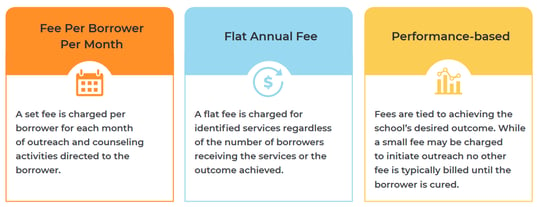Definitive Guide to Student Loan Default Prevention
The Current Situation
-
43%of borrowers were behind on payments as of February 2025, with more than 9 million on the path to default by the end of 2025.
Source: VantageScore -
129pointspotential decline in credit score that delinquent borrowers could experience, severely impacting their ability to secure loans, mortgages, and other financial products.
Source: VantageScore -
73%
- Accountability and Compliance: Schools are held accountable for their former students' loan repayment performance. The U.S. Department of Education monitors repayment rates and can impose sanctions on schools with high default rates. Providing support can ensure compliance with federal standards.
- Competitive Advantage: Repayment support can differentiate your school from others, making it more attractive to students who are concerned about post-graduation debt.
- Retention and Graduation Rates: For current students, knowing that their institution offers post-graduation loan support can improve retention and graduation rates, as students feel more secure about their financial future.
- Social Responsibility: Demonstrating a commitment to helping former students manage their debt aligns with broader social responsibility goals and can enhance your school’s public image.
- Increased Donations: Alums who feel supported by their alma mater are more likely to give back financially, potentially increasing donations and endowments.
- Access to Federal Funding: Schools with poor repayment performance may see restrictions on access to federal student aid programs. By helping former students repay their loans, you can maintain eligibility for these crucial funding sources.
Advantages of Hiring a Provider
Hiring a vendor to provide student loan repayment support offers many advantages over managing it internally.
- Expertise and Experience: Vendors specialize in student loan repayment support and have extensive experience and knowledge in this area. They can provide tailored solutions and best practices that you might not have in-house.
- Cost-Effectiveness: Setting up and maintaining an internal support system can be costly and resource intensive. Vendors can offer scalable solutions that might be more cost-effective in the long run.
- Time Savings: Implementing and managing a student loan repayment support program requires significant time and effort. By outsourcing, you can focus on your core mission and activities while the vendor handles the complexities of the program.
- Access to Advanced Tools and Technology: Vendors often have access to the latest tools and technology to manage student loans efficiently. This can include sophisticated software for analyzing student loan data, providing personalized advice, and ensuring compliance with policies.
- Compliance and Regulation: Student loan repayment involves navigating complex regulations and compliance requirements. Vendors are well-versed in these areas and can help ensure that you remain compliant with all relevant laws and regulations.
- Enhanced Support Services: Vendors can offer a range of support services, such as financial education, personalized guidance, and repayment plan enrollment, which might be challenging for you to provide internally.
- Scalability: As the number of alums grows, the demand for student loan repayment support may increase. Vendors can easily scale their services to meet this growing demand without you needing to invest in additional resources.
- Data Security: Vendors typically have robust data security measures in place to protect sensitive financial information, which can be a significant concern when managing this data internally.
- Improved Outcomes: With their specialized knowledge and resources, vendors can often achieve better outcomes for alums, such as lower default rates and more efficient repayment plans.
- Focus on Core Competencies: By outsourcing student loan repayment support, you can focus on your core competencies, such as providing quality education and enhancing student experiences, rather than diverting resources to manage loan repayment programs.
Jump-Start Your Search for a Provider
If your school has decided to outsource repayment support, these six steps could help jump-start your search and lead you to the provider that best meets your needs and delivers the results your desire.

![]() Get started and download 6 Steps to Choosing a Default Prevention Provider.
Get started and download 6 Steps to Choosing a Default Prevention Provider.
In general, you can use a Request for Proposal (RFP) to facilitate your search. Or maybe you simply pose questions through phone conversations. Either way, having clear goals helps you determine which solution is best. Knowing your requirements and identifying "nice-to-haves" are critical in helping to find the best option for you and your students.
![]() Download this handy Checklist to Compare Default Prevention Providers and find the best fit.
Download this handy Checklist to Compare Default Prevention Providers and find the best fit.
Pricing Guide
Just like there are multiple ways to engage and counsel student loan borrowers, there are multiple pricing models for default prevention services.

![]() Download Default Prevention Pricing Guide to compare the top methods and look at their pros and cons.
Download Default Prevention Pricing Guide to compare the top methods and look at their pros and cons.
![]() Request a QUICK QUOTE to get our program details and customized fees.
Request a QUICK QUOTE to get our program details and customized fees.
Uncover an Insider's Guide to Cohort Default Rates
The U.S. government’s main metric for school accountability in keeping student loan borrowers out of default is the three-year Cohort Default Rate (CDR). A CDR is the percentage of a school's U.S. Federal Stafford loan borrowers (Direct/Federal Family Education Loan Program) who enter repayment during a federal fiscal year and default within the cohort default period. The monitoring period begins on October 1 of the fiscal year when the borrower enters repayment and ends on September 30 of the following two fiscal years.
![]() Download Insider’s Guide to Cohort Default Rate to learn more or to share information with your colleagues.
Download Insider’s Guide to Cohort Default Rate to learn more or to share information with your colleagues.
Attigo Can Help
We offer outreach, education, and guidance to help former students avoid delinquency and default and achieve their financial goals.